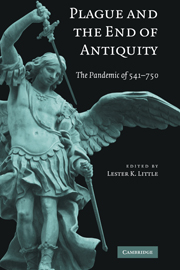Book contents
- Frontmatter
- Contents
- Contributors
- Preface
- Map
- Plague and the End of Antiquity
- I INTRODUCTION
- II THE NEAR EAST
- III THE BYZANTINE EMPIRE
- IV THE LATIN WEST
- 7 Consilia humana, ops divina, superstitio
- 8 Plague in Spanish Late Antiquity
- 9 Plague in Seventh-Century England
- 10 The Plague and Its Consequences in Ireland
- V THE CHALLENGE OF EPIDEMIOLOGY AND MOLECULAR BIOLOGY
- Bibliography
- Index
10 - The Plague and Its Consequences in Ireland
Published online by Cambridge University Press: 05 June 2012
- Frontmatter
- Contents
- Contributors
- Preface
- Map
- Plague and the End of Antiquity
- I INTRODUCTION
- II THE NEAR EAST
- III THE BYZANTINE EMPIRE
- IV THE LATIN WEST
- 7 Consilia humana, ops divina, superstitio
- 8 Plague in Spanish Late Antiquity
- 9 Plague in Seventh-Century England
- 10 The Plague and Its Consequences in Ireland
- V THE CHALLENGE OF EPIDEMIOLOGY AND MOLECULAR BIOLOGY
- Bibliography
- Index
Summary
Analyses of plague visitations in medieval Ireland, including the epidemic of 544, were first advanced in some detail by William P. MacArthur in 1949. Apart from the discussion by J. R. Maddicott of the plague in seventh-century England, which also uses Irish evidence, there has been no subsequent analysis of the Irish material in any detailed way. It may be useful then, in fleshing out the trajectory and consequences of the Justinianic Plague outbreaks in Europe generally, to consider the evidence from Ireland, where a contemporary annalistic record survives. The witness afforded by these early Irish records remains sketchy, however, and thus part of the purpose of this essay, besides assessing the outbreaks themselves and their immediate historical consequences, is to map something of the cultural form that evolved from the impact of these events; plague visitations provide an insight into the formation of a particular crisis-management mentality in Ireland and Irish-influenced European zones.
The arrival of a plague in Ireland in 544 would seem to concur with the westward trajectory of the outbreak of Justinianic Plague at this time; it had arrived in central Gaul by 543. The exact mode of ingress is not clear, but one possible way was the one that ran through the western route from Narbonne to the Garonne and thence past Brittany to western Britain. Such a route extends to southern Ireland also and does not necessarily make landfall in Britain.
- Type
- Chapter
- Information
- Plague and the End of AntiquityThe Pandemic of 541–750, pp. 215 - 228Publisher: Cambridge University PressPrint publication year: 2006
- 3
- Cited by

